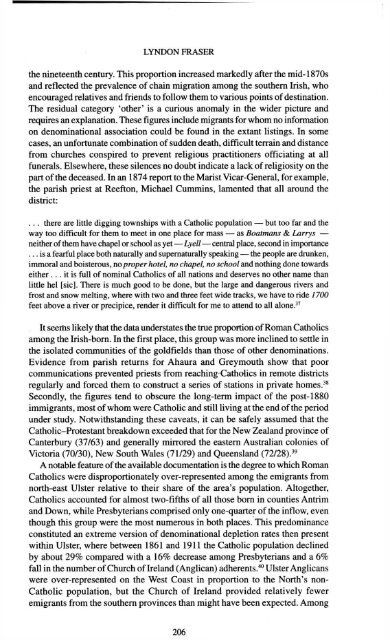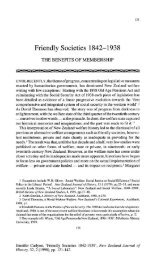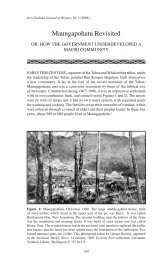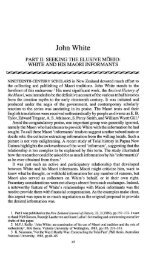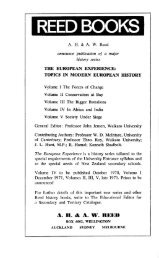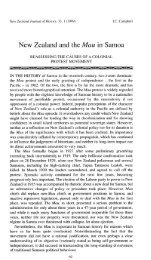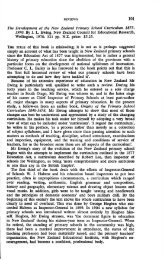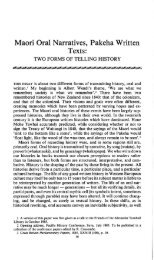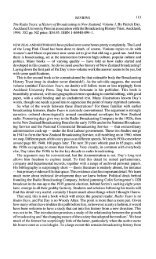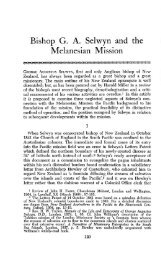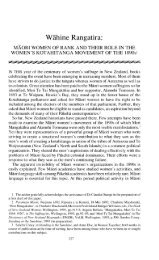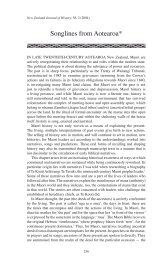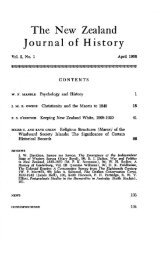Irish Migration to the West Coast, 1864-1900 - New Zealand Journal ...
Irish Migration to the West Coast, 1864-1900 - New Zealand Journal ...
Irish Migration to the West Coast, 1864-1900 - New Zealand Journal ...
Create successful ePaper yourself
Turn your PDF publications into a flip-book with our unique Google optimized e-Paper software.
LYNDON FRASER<br />
<strong>the</strong> nineteenth century. This proportion increased markedly after <strong>the</strong> mid-1870s<br />
and reflected <strong>the</strong> prevalence of chain migration among <strong>the</strong> sou<strong>the</strong>rn <strong>Irish</strong>, who<br />
encouraged relatives and friends <strong>to</strong> follow <strong>the</strong>m <strong>to</strong> various points of destination.<br />
The residual category 'o<strong>the</strong>r' is a curious anomaly in <strong>the</strong> wider picture and<br />
requires an explanation. These figures include migrants for whom no information<br />
on denominational association could be found in <strong>the</strong> extant listings. In some<br />
cases, an unfortunate combination of sudden death, difficult terrain and distance<br />
from churches conspired <strong>to</strong> prevent religious practitioners officiating at all<br />
funerals. Elsewhere, <strong>the</strong>se silences no doubt indicate a lack of religiosity on <strong>the</strong><br />
part of <strong>the</strong> deceased. In an 1874 report <strong>to</strong> <strong>the</strong> Marist Vicar-General, for example,<br />
<strong>the</strong> parish priest at Reef<strong>to</strong>n, Michael Cummins, lamented that all around <strong>the</strong><br />
district:<br />
. . . <strong>the</strong>re are little digging <strong>to</strong>wnships with a Catholic population — but <strong>to</strong>o far and <strong>the</strong><br />
way <strong>to</strong>o difficult for <strong>the</strong>m <strong>to</strong> meet in one place for mass •— as Boatmans & Larrys —<br />
nei<strong>the</strong>r of <strong>the</strong>m have chapel or school as yet — Lyell—central place, second in importance<br />
... is a fearful place both naturally and supernaturally speaking — <strong>the</strong> people are drunken,<br />
immoral and boisterous, no proper hotel, no chapel, no school and nothing done <strong>to</strong>wards<br />
ei<strong>the</strong>r ... it is full of nominal Catholics of all nations and deserves no o<strong>the</strong>r name than<br />
little hel [sic]. There is much good <strong>to</strong> be done, but <strong>the</strong> large and dangerous rivers and<br />
frost and snow melting, where with two and three feet wide tracks, we have <strong>to</strong> ride 1700<br />
feet above a river or precipice, render it difficult for me <strong>to</strong> attend <strong>to</strong> all alone. 37<br />
It seems likely that <strong>the</strong> data understates <strong>the</strong> true proportion of Roman Catholics<br />
among <strong>the</strong> <strong>Irish</strong>-born. In <strong>the</strong> first place, this group was more inclined <strong>to</strong> settle in<br />
<strong>the</strong> isolated communities of <strong>the</strong> goldfields than those of o<strong>the</strong>r denominations.<br />
Evidence from parish returns for Ahaura and Greymouth show that poor<br />
communications prevented priests from reaching Catholics in remote districts<br />
regularly and forced <strong>the</strong>m <strong>to</strong> construct a series of stations in private homes. 38<br />
Secondly, <strong>the</strong> figures tend <strong>to</strong> obscure <strong>the</strong> long-term impact of <strong>the</strong> post-1880<br />
immigrants, most of whom were Catholic and still living at <strong>the</strong> end of <strong>the</strong> period<br />
under study. Notwithstanding <strong>the</strong>se caveats, it can be safely assumed that <strong>the</strong><br />
Catholic-Protestant breakdown exceeded that for <strong>the</strong> <strong>New</strong> <strong>Zealand</strong> province of<br />
Canterbury (37/63) and generally mirrored <strong>the</strong> eastern Australian colonies of<br />
Vic<strong>to</strong>ria (70/30), <strong>New</strong> South Wales (71/29) and Queensland (72/28). 39<br />
A notable feature of <strong>the</strong> available documentation is <strong>the</strong> degree <strong>to</strong> which Roman<br />
Catholics were disproportionately over-represented among <strong>the</strong> emigrants from<br />
north-east Ulster relative <strong>to</strong> <strong>the</strong>ir share of <strong>the</strong> area's population. Al<strong>to</strong>ge<strong>the</strong>r,<br />
Catholics accounted for almost two-fifths of all those born in counties Antrim<br />
and Down, while Presbyterians comprised only one-quarter of <strong>the</strong> inflow, even<br />
though this group were <strong>the</strong> most numerous in both places. This predominance<br />
constituted an extreme version of denominational depletion rates <strong>the</strong>n present<br />
within Ulster, where between 1861 and 1911 <strong>the</strong> Catholic population declined<br />
by about 29% compared with a 16% decrease among Presbyterians and a 6%<br />
fall in <strong>the</strong> number of Church of Ireland (Anglican) adherents. 40 Ulster Anglicans<br />
were over-represented on <strong>the</strong> <strong>West</strong> <strong>Coast</strong> in proportion <strong>to</strong> <strong>the</strong> North's non-<br />
Catholic population, but <strong>the</strong> Church of Ireland provided relatively fewer<br />
emigrants from <strong>the</strong> sou<strong>the</strong>rn provinces than might have been expected. Among<br />
206


